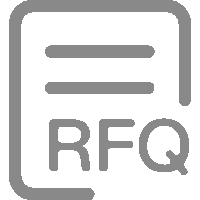-
Products
- Logic ICs
- Sensors
- Interface ICs
- Optocouplers
- Wireless & RF Integrated Circuits
- Microcontrollers - MCU
- FFC & FPC Connectors
- Switch ICs
- Headers & Wire Housings
- TVS Diodes / ESD Suppression Diodes
- Communication & Networking ICs
- PMIC - Power Management ICs
- Diodes & Rectifiers
- Infrared Data Communications
- Inductors, Chokes & Coils
- DC-DC Converters
- Driver ICs
- Potentiometers, Trimmers & Rheostats
- Memory & Data Storage
- Ferrites
- Supplies
- Counter ICs
- Fiber Optic
- Wire & Cable Management
- Programmable Logic ICs
- LEDs
- MOSFETs
- PPTC Resettable Fuses
- Amplifier ICs
- RF Interconnects
- Data Converter ICs
- Security ICs / Authentication ICs
- Thyristors
- Clock & Timer ICs
- AC-DC Power Supply
- Optical Detectors & Sensors
- Development Tools
- Wireless & RF Modules
- Computing
- Data Bus Components
- I/O Connectors
- Video ICs
- Antennas
- Enclosures, Racks and Boxes
- Lamps (Non-LED)
- Microprocessors - MPU
- Modular Connectors / Ethernet Connectors
- Board to Board & Mezzanine Connectors
- LED Indication
- Equalizers
- SOC - Systems on a Chip
- Embedded Processors & Controllers
- USB Connectors
- Memory Connectors & Sockets
- Audio ICs
- Audio Devices
- Hardware
- Power Connectors
- Switch Accessories
- Card Edge Connectors
- Varistors
- RF Transistors
- Audio & Video Connectors
- D-Sub Connectors
- IC & Component Sockets
- Optical Switches
- Contactors
- Power Condition
- Pin & Socket Connectors
- Test Leads, Banana Plugs, Alligator Clips & Test Probes
- Lasers
- Embedded Solutions
- Thermal Management
- Thermistors
- PMIC - Voltage Regulators - DCDC Switching Regulators
-
FEATURED PRODUCTS
-
IT infrastructure
- OEM Souring
- Hard Drives
- CPU
- IT infrastructure Memory
- Spare Parts
- Cables
- Power Supply Units
- Adapters
- Controllers
- Server
- Switch
- Network Cards
- IT infrastructure Accessories
- Storage Machines
- Systemboard
- Sfp
- Harddrives
- Heatsink
- Fan
- Rack Options
- Licenses
- Battery
- Racks
- Graphics
- Io Expansions
- Routers
- San
- Access Point
- Blades
- Firewalls
- Expansion Cards
- Software
- Chassis
- Flex System
- Ups
- Wifi Controller
- Bladecenters
- Rack Mounts
- Monitors
- Antenna
- Phones
- Hmc
- HOT - SALES and EOL Components
- 88E series
- Maxim Series
- Hard To Find
- END - OF - LIFE
- Electronic Surplus
- Newest Parts
- Electrical Parts
- Electronic Wholesale
- TPS series
- STM series
- SEE ALL

-
IT infrastructure
-
Integrated Circuits (ICs)
- Clock/Timing
- Data Acquisition
-
Embedded
- Embedded - CPLDs (Complex Programmable Logic Devices)
- Embedded - DSP (Digital Signal Processors)
- Embedded - FPGAs (Field Programmable Gate Array)
- Embedded - Microcontrollers
- Embedded - Microcontrollers - Application Specific
- Embedded - Microprocessors
- Embedded - PLDs (Programmable Logic Device)
- Embedded - System On Chip (SoC)
- SEE ALL
-
Interface
- Interface - Analog Switches - Special Purpose
- Interface - Analog Switches, Multiplexers, Demultiplexers
- Interface - CODECs
- Interface - Controllers
- Interface - Drivers, Receivers, Transceivers
- Interface - Encoders, Decoders, Converters
- Interface - Filters - Active
- Interface - I/O Expanders
- Interface - Modems - ICs and Modules
- Interface - Sensor and Detector Interfaces
- Interface - Serializers, Deserializers
- Interface - Signal Buffers, Repeaters, Splitters
- Interface - Signal Terminators
- Interface - Specialized
- Interface - Telecom
- Interface - UARTs (Universal Asynchronous Receiver Transmitter)
- Interface - Voice Record and Playback
- SEE ALL
- Linear
-
Logic
- Logic - Buffers, Drivers, Receivers, Transceivers
- Logic - Comparators
- Logic - Counters, Dividers
- Logic - FIFOs Memory
- Logic - Flip Flops
- Logic - Gates and Inverters
- Logic - Latches
- Logic - Multivibrators
- Logic - Parity Generators and Checkers
- Logic - Shift Registers
- Logic - Signal Switches, Multiplexers, Decoders
- Logic - Specialty Logic
- Logic - Translators, Level Shifters
- Logic - Universal Bus Functions
- Logic - Gates and Inverters - Multi - Function, Configurable
-
PMIC
- PMIC - AC DC Converters, Offline Switchers
- PMIC - Battery Chargers
- PMIC - Battery Management
- PMIC - Current Regulation/Management
- PMIC - Display Drivers
- PMIC - Energy Metering
- PMIC - Full, Half - Bridge Drivers
- PMIC - Gate Drivers
- PMIC - Hot Swap Controllers
- PMIC - Laser Drivers
- PMIC - LED Drivers
- PMIC - Lighting, Ballast Controllers
- PMIC - Motor Drivers, Controllers
- PMIC - OR Controllers, Ideal Diodes
- PMIC - PFC (Power Factor Correction)
- PMIC - Power Distribution Switches, Load Drivers
- PMIC - Power Management - Specialized
- PMIC - Power Over Ethernet (PoE) Controllers
- PMIC - Power Supply Controllers, Monitors
- PMIC - RMS to DC Converters
- PMIC - Supervisors
- PMIC - Thermal Management
- PMIC - V/F and F/V Converters
- PMIC - Voltage Reference
- PMIC - Voltage Regulators - DC DC Switching Controllers
- PMIC - Voltage Regulators - DC DC Switching Regulators
- PMIC - Voltage Regulators - Linear
- PMIC - Voltage Regulators - Linear Regulator Controllers
- PMIC - Voltage Regulators - Linear + Switching
- PMIC - Voltage Regulators - Special Purpose
- SEE ALL
- Specialized ICs
- Audio Special Purpose
- Memory
- SEE ALL

- Coaxial Connectors (RF) -Adapters
- COLD SHRINK TUBING
-
Discrete Semiconductor Products
- Current Regulation - Diodes, Transistors
- IGBTs - Arrays
- RF Diodes
- Transistors
- Bridge Rectifiers
- Diacs, Sidacs
- Diodes - Zener - Arrays
- Diodes - Zener - Single
- Diodes, Rectifiers - Arrays
- Diodes, Rectifiers - Single
- FETs - Arrays
- FETs - Single
- IGBTs - Modules
- IGBTs - Single
- JFETs (Junction Field Effect)
- Power Drivers - Modules
- RFFETs
- SCRs - Single - Modules
- SCRs - Single
- Triacs
- Variable Capacitance Diodes (Varicaps, Varactors)
- SEE ALL

- Circuit Protection
- Optoelectronics
-
Sensors, Transducers
-
Optical Sensors
- Optical Sensors - Ambient Light, IR, UV Sensors
- Optical Sensors - Photo Detectors - Remote Receiver
- Optical Sensors - Photodiodes
- Optical Sensors - Photointerrupters - SlotType - LogicOutput
- Optical Sensors - Photointerrupters - SlotType - TransistorOutput
- Optical Sensors - Phototransistors
- Optical Sensors - Reflective - Analog Output
- SEE ALL
- Motion Sensors
- Temperature Sensors
- Magnetic Sensors
- Moisture Sensors, Humidity
- Position Sensors - Angle, Linear Position Measuring
- Pressure Sensors, Transducers
- Proximity Sensors
- Capacitive Touch Sensors, Proximity Sensor ICs
- Current Transducers
- Encoders
- Image Sensors, Camera
- IrDA Transceiver Modules
- SEE ALL

-
Optical Sensors
-
Connectors, Interconnects
- AC Power Connectors
- D - SUB, D - SHAPED connectors
- FFC, FPC (FlatFlexible) Connectors
- Card Edge Connectors - Edgeboard Connectors
- Circular Connectors
- Memory Connectors - PC Card Sockets
- Modular Connectors
- Pluggable Connectors
- Power Entry Connectors - Inlets, Outlets, Modules
- Rectangular - Board to Board Connectors
- Rectangular Connectors
- Sockets for ICs, Transistors
- Terminal Blocks
- Terminals
- USB, DVI, HDMI Connectors
- Backplane Connectors
- Coaxial Connectors (RF)
- SEE ALL

- Capacitors
- Resistors
- Relays
- Isolators
- Filters
- Memory Cards, Modules
- Power Supplies - Board Mount
-
RF/IF and RFID
- RFID Reader Modules
- RF Multiplexers
- Attenuators
- Balun
- RF Amplifiers
- RF Antennas
- RF Demodulators
- RF Detectors
- RF Diplexers
- RF Directional Coupler
- RF Evaluation and Development Kits, Boards
- RF Front End (LNA + PA)
- RF Misc ICs and Modules
- RF Mixers
- RF Modulators
- RF Power Dividers/Splitters
- RF Receivers
- RF Switches
- RF Transceiver ICs
- RF Transceiver Modules
- RF Transmitters
- RFID, RF Access, Monitoring ICs
- SEE ALL

- Crystals, Oscillators and Resonators
-
Uncategorized

- Audio Products
- Cable Assemblies
- Cables, Wires
- Cables, Wires - Management
- Hardware, Fasteners, Accessories
- Inductors, Coils, Chokes
- Industrial Controls, Meters
- Potentiometers, Variable Resistors
-
Programmers, Development Systems
- Evaluation Boards - Embedded - Complex Logic (FPGA, CPLD)
- Evaluation Boards - Linear Voltage Regulators
- Evaluation and Demonstration Boards and Kits
- Evaluation Boards - Analog to Digital Converters (ADCs)
- Evaluation Boards - Audio Amplifiers
- Evaluation Boards - DC/DC & AC/DC (Off - Line)SMPS
- Evaluation Boards - Embedded - MCU, DSP
- Evaluation Boards - Expansion Boards
- Evaluation Boards - Op Amps
- Evaluation Boards - Sensors
- SEE ALL

- Switches
- Transformers
- SEE ALL
-
Manufacturers
- Altera
- Analog Devices Inc.
- Atmel
- Bosch Sensortec
- Cypress Semiconductor Corp
- Diodes Incorporated
- Freescale Semiconductor - NXP
- FTDI, Future Technology Devices International Ltd
- Infineon Technologies
- Linear Technology
- Marvell
- Maxim Integrated
- Microchip Technology
- Micron Technology Inc.
- NXP
- ON Semiconductor
- Shandong Goldencell Energy Technology Co. Ltd
- Silicon Labs
- STMicroelectronics
- Texas Instruments
- SEE ALL
- My Account
- Supports
- About Us
- Group
- Contact Us
Please log in to request free sample.
Thank you for reaching out to WIN SOURCE. Your RFQ has been received, and our team will contact you within 24 hours to discuss your requirements.
Copyright © 2025 WIN SOURCE. All rights reserved.
For detailed contact information and office addresses in our key locations, including Irvine, Munich, Toronto, Singapore, Seoul, Bangalore, Bologna, Yamanashi, Hong Kong, and Mainland China, please visit our website.






